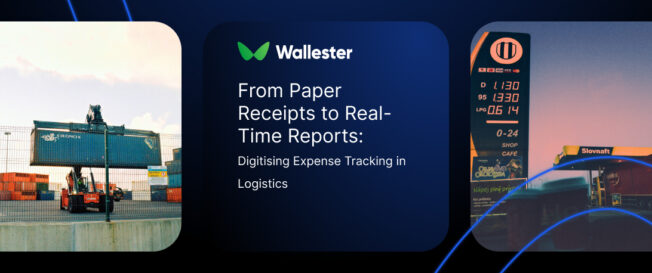Tracking costs in logistics is never simple. Fuel, meals, hotels, tolls, and maintenance all pile up quickly, and every pound must be accounted for. Paper receipts and spreadsheets slow everything down, leaving finance teams buried in admin and employees waiting for reimbursements. Digital expense tracking gives transport companies real-time visibility, faster approvals, and cleaner records. It replaces guesswork with accurate data and helps managers control spend without adding more pressure on staff.
Overview
Transport and logistics are cost-heavy industries. Vehicles consume fuel across long routes, staff travel internationally, and warehouses generate constant small purchases. Every one of these expenses needs to be logged, approved, and reimbursed. In the past, this meant filing receipts into envelopes and building spreadsheets that took hours to reconcile. That approach no longer works.
Companies now rely on expense management software that cuts admin time and gives managers a clear view of spending. Instead of waiting weeks for reports, finance teams can check expense data in real time. This helps firms stay compliant with tax rules, apply company policies consistently, and reduce errors caused by manual data entry. With the right expense management system in place, expenses stop being a distraction and start supporting better financial reporting and decision-making.
Why is managing business expenses so important in logistics?
Expenses in logistics are frequent and unavoidable. Drivers need fuel and meals, managers travel to meet partners, and staff spend on accommodation during business trips. Each of these transactions becomes part of the company’s accounts. If the process of recording and approving them is weak, financial planning suffers.
Proper expense management guarantees that costs are visible, categorised, and controlled. For example, a company that tracks fuel separately from accommodation can see where budgets are being exceeded and take action quickly. Mileage claims and tolls may reveal that certain routes are more expensive than others, prompting managers to adjust schedules. Without these insights, costs go unnoticed until they affect profitability.
Compliance is another reason expense management is important. Logistics firms deal with different tax regimes, VAT rates, and payroll requirements across multiple countries. Poorly managed expense claims expose the company to penalties and disputes. Finance teams need structured expense policies and a reliable expense management process to avoid mistakes.
Finally, well-handled expenses support employee trust. Staff who are reimbursed promptly are more likely to follow company policies and less likely to feel resentful. A clear process protects both sides and reduces unnecessary conflict.
Further Reading: The Complete Guide to Managing Expenses for Transport & Logistics Companies
Top expense management challenges facing the transportation and logistics industry
The logistics industry faces several obstacles in managing expenses that do not affect other sectors in the same way. The scale of employee expenses and the constant cross-border activity add layers of complexity that paper-based processes cannot handle.
The most common problems are:
- Receipts lost or damaged before they reach finance teams.
- Transactions in different currencies, which complicate reconciliation.
- Slow, manual data entry that eats up admin time.
- Approval processes that delay reimbursements for employees.
- Compliance risks from VAT and payroll rules that vary across countries.
These challenges often occur simultaneously. A driver might lose a fuel receipt while also being reimbursed in the wrong currency, leaving finance teams with inaccurate data. Managers waiting weeks for expense reports cannot spot trends in time to act. When multiplied across hundreds of employees, these issues create significant inefficiencies that cut into already thin margins.
Why paper-based processes aren’t working anymore
Paper receipts once seemed manageable, but anyone who has handled them knows the reality. Drivers return from long trips with crumpled slips from fuel stations, hotels, and roadside cafés. By the time they hand them over, half are unreadable or missing. Finance staff spend hours chasing duplicates or entering figures manually into spreadsheets.
The delay is just as harmful. Paper receipts are usually submitted in bulk at the end of the month, leaving finance teams with a backlog of expense reports. This slows down reimbursements and delays financial reporting. Managers trying to understand costs only get visibility weeks later, by which time it is too late to make changes.
Accuracy is another problem. Manual entry introduces errors, whether through typos or miscategorisation. Even a small mistake in a mileage claim can distort financial reporting. With logistics companies operating on thin margins, this is unacceptable. These weaknesses explain why paper-based processes are being replaced with digital expense management systems.
The best techniques for streamlining expense management
Logistics firms can improve expense management by combining strong company policies with modern tools. Employees need to know exactly what they can claim, and finance teams need processes that remove repetitive manual tasks.
Effective techniques include:
- Defining clear expense categories so claims are consistent and easier to reconcile.
- Providing mobile apps that allow employees to upload receipts immediately.
- Issuing corporate cards or virtual cards so card transactions are tracked automatically.
- Applying spending policies and expense rules to reduce mistakes and improve compliance.
When companies adopt these techniques, expense management becomes faster and more reliable. Employees no longer need to hold on to piles of receipts. Finance teams save time, and managers gain real-time insights into company spending.
Further Reading: Top Ways to Streamline Expense Management Across Transport and Logistics
How to automate expense management for logistics
Automation in logistics expense management replaces the steps that used to slow everything down. Key improvements include:
- Instant capture: drivers take a photo of a receipt in the mobile app, and the details are stored straight away.
- Quick approvals: managers get a notification and can check claims immediately, rather than waiting for a monthly report.
- Reconciliation done for you: receipts are paired with card transactions automatically, saving hours of checking.
- Policy checks: expense rules are applied as claims come in, so anything outside company guidelines is flagged at once.
- Real-time reporting: accounting software updates as soon as expenses are submitted, giving an up-to-date view of spending.
For logistics firms, this means quicker reimbursements for staff, cleaner records for finance teams, and better oversight for managers. Everyone sees the benefit in day-to-day work, from drivers on the road to those preparing financial reports.

How does expense tracking software work?
Expense management software acts as a central system that connects employees, managers, and finance teams. Employees upload receipts through a mobile app or use corporate cards linked to the platform. The software scans receipts, extracts data, and categorises expenses automatically.
Claims are then routed through an approval process. Managers review them in real time, rather than waiting for end-of-month submissions. Finance teams see the data on dashboards that show total company spending, employee expenses, and compliance with policies.
The system integrates with accounting software, so expense data flows directly into financial reporting. Reimbursements are processed faster, and errors are avoided. The expense management process becomes smoother, with less admin time required at every stage.
Further Reading: How Virtual Cards Simplify Corporate Expense Tracking
Key features of expense tracking software
The best expense management software comes with comprehensive features to handle the high volume and complexity of logistics. Among the most useful features are:
- Receipt scanning with automatic data extraction.
- Mobile apps for employees to report expenses on the move.
- Multi-currency support for operations in multiple countries.
- Approval workflows that cut admin time.
- Built-in compliance checks aligned with company policies.
- Corporate cards and virtual cards linked to expense trackers.
These key features allow companies to control spend, improve accuracy, and make the entire expense management process easier for both employees and finance teams.
Benefits of the expense trackers for transport & logistics
Expense trackers deliver significant benefits to logistics companies, improving the experience for employees, managers, and finance teams.
- Employees are reimbursed faster, which improves morale.
- Compliance with company policies and tax rules is easier to maintain.
- Consistent expense categories lead to more accurate reporting.
- Finance teams save time by avoiding manual data entry.
- Managers gain complete visibility of spending and can spot trends early.
The overall benefit is efficiency. Companies cut admin time, reduce costs, and make better financial decisions. Expense management becomes a strategic advantage rather than an administrative burden.
Drawbacks of the expense trackers for transport & logistics
Despite the benefits, expense management systems are not perfect. Some employees may resist using mobile apps, especially if they are used to paper receipts. Training and clear communication are necessary to overcome this.
Costs can also be a concern for small businesses. While subscription fees are outweighed by time savings in most cases, the upfront commitment can be a barrier.
Integration with existing accounting software is another challenge. Not all platforms connect smoothly, which can create extra work. This is why choosing the right expense management solution is critical. Firms need to evaluate options carefully to avoid gaps in their financial processes.
Choosing an expense-tracking system
When selecting an expense management system, companies should look at their current needs and future growth. A good system should support today’s financial processes but also scale with the business.
Important factors to consider include:
- Compatibility with accounting software for reconciliation and reporting.
- Comprehensive features such as receipt scanning, mobile apps, and multi-currency support.
- User-friendly design so employees can submit expenses easily.
- Dashboards that give managers and finance teams full control.
- Vendor support and expert guidance to assist with implementation.
By weighing these factors, logistics companies can choose the best expense management software to reduce admin time, improve compliance, and gain reliable financial reporting.
Why choose Wallester?
Wallester offers an expense management platform that fits the everyday needs of logistics firms. Instead of relying on scattered tools, everything is handled in one system. Companies can issue cards, set budgets, track spending in real time, and keep records clean for finance teams without adding extra workload.
The flexibility of the platform is what makes it useful. Cards can be issued instantly, either physical or virtual, and managers decide how they are used. Limits can be set per team, route, or project. Spending rules apply automatically so a card may be restricted to fuel or accommodation only. Every payment is shown in the dashboard at the moment it happens, and staff receive reminders to upload receipts. Accounting integration means finance teams no longer re-enter data, and reconciliation is much faster.
A few examples of what companies gain with Wallester include:
- Instant issue of corporate and virtual Visa cards with tailored limits
- Spending policies that apply to each card automatically
- Real-time dashboards showing transactions across the fleet
- Push notifications that remind employees to attach receipts
- Integration with accounting systems for accurate reporting
For logistics teams this means less delay, fewer mistakes, and a clearer view of how money is being spent across vehicles, drivers, and departments. Managers stay informed, finance staff work with reliable data, and employees have a straightforward way to cover costs without using personal cards.
Case studies
A European logistics company introduced Wallester to manage expenses for drivers across several countries. Before, employees submitted receipts in bulk, causing delays and errors. After adopting Wallester, drivers submitted claims directly through the mobile app. Card transactions were matched automatically, and VAT reconciliation was simplified. The result was a significant reduction in admin time and faster reimbursements.
Another transport provider used Wallester’s corporate cards for fuel and travel costs. Spending policies were applied to each card, giving managers immediate visibility of expenses. Finance teams used the dashboards to spot overspending on certain routes and adjusted budgets accordingly. Employees were reimbursed more quickly, and the company reported significant savings.
Simplify your expense management with Wallester
Expense management does not need to slow down logistics firms. Wallester offers an expense management solution with comprehensive features that cut admin time, improve compliance, and give finance teams complete visibility of expenses.

Get started with Wallester today and give your team instant access to smart expense tools – from issuing cards in seconds to tracking spending in real time.


